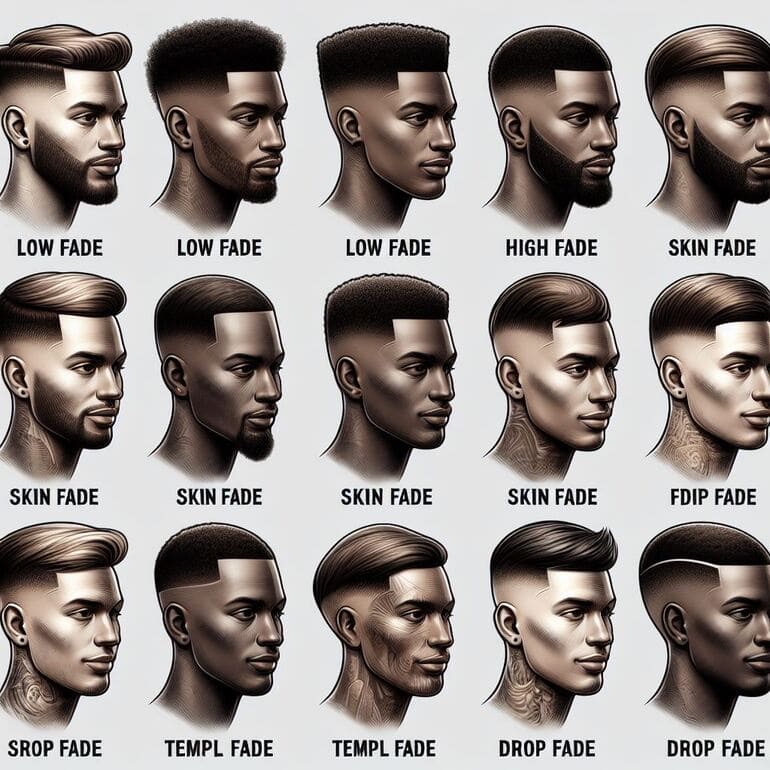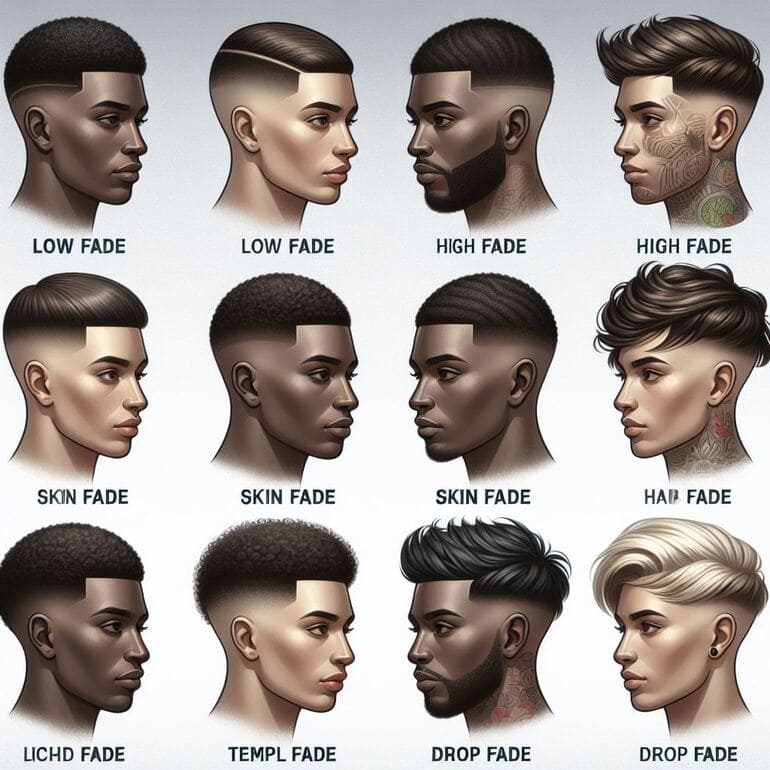Fades: A Comprehensive Guide to the Different Types of Fades
Fades are a popular haircutting technique that involves gradually blending the hair from short to long, creating a smooth transition.

This versatile style can be customized to suit different face shapes, hair types, and personal preferences. Whether you’re looking for a subtle fade or a more dramatic one, there’s a fade out there for everyone.
Types of Fades
There are several different types of fades, each with its own unique characteristics. Here are some of the most common:
1. High Fade:
- The high fade starts high on the sides and back of the head, just below the crown.
- The hair is gradually blended down to a shorter length, creating a sharp contrast between the longer hair on top and the shorter hair on the sides.
- This fade is ideal for those who want a bold and edgy look.
2. Mid Fade:
- The mid fade starts at the middle of the sides and back of the head.
- The hair is gradually blended down to a shorter length, creating a more subtle contrast between the longer hair on top and the shorter hair on the sides.
- This fade is a good option for those who want a more versatile look that can be dressed up or down.
3. Low Fade:
- The low fade starts low on the sides and back of the head, just above the neckline.
- The hair is gradually blended down to a shorter length, creating a very subtle contrast between the longer hair on top and the shorter hair on the sides.
- This fade is ideal for those who want a natural and understated look.
4. Skin Fade:
- The skin fade is the most extreme type of fade, where the hair is blended down to the skin on the sides and back of the head.
- This fade creates a very sharp and defined contrast between the longer hair on top and the shaved hair on the sides.
- The skin fade is a bold and edgy style that is perfect for those who want to make a statement.
5. Burst Fade:
- The burst fade is a variation of the high fade that features a “burst” of longer hair at the temples.
- This fade is ideal for those who want to add a bit of personality and flair to their fade.
6. Drop Fade:
- The drop fade is another variation of the high fade that features a “drop” of longer hair at the back of the head.
- This fade is ideal for those who want to add some length and volume to their fade.
Choosing the Right Fade
The best fade for you will depend on your individual face shape, hair type, and personal preferences. Here are a few things to consider when choosing a fade:
- Face Shape:
- High fades are best suited for oval and round faces.
- Mid fades are best suited for square and diamond faces.
- Low fades are best suited for long and narrow faces.
- Hair Type:
- Thick hair is best suited for high and mid fades.
- Thin hair is best suited for low fades and skin fades.
- Personal Preferences:
- Consider your lifestyle and personal style when choosing a fade.
- If you want a bold and edgy look, go for a high fade or a skin fade.
- If you want a more versatile look, go for a mid-fade or a low fade.
How to Ask for a Fade
When asking your barber for a fade, be sure to specify the type of fade you want (high, mid, low, skin, etc.) and the length of the hair you want on top. You can also show your barber a picture of the fade you’re looking for.

Fades are a versatile and stylish haircutting technique that can be customized to suit any individual. With so many different types of fades to choose from, there’s sure to be a fade out there that’s perfect for you.
Frequently Asked Questions about types of fades:
What is a fade haircut, and what are the different types of fades?
A fade haircut is a hairstyle where the hair is cut exceedingly short, usually fading away from the face and neck. There are several types of fades, including:
- High and Tight Fade: This type of fade involves cutting the hair on top short and leaving a medium-length bosom around the temples.
- Low Fade: A low fade involves cutting the hair on top very short, with a gradual reduction in length as you move towards the back of the head.
- Mid Fade: A mid fade is similar to a low fade, but the reduction in length is not as dramatic.
- High Fade: A high fade involves cutting the hair on top very short, with a gradual increase in length as you move towards the back of the head.
- Pompadour Fade: This type of fade involves cutting the hair on top longer to achieve a pompadour shape, with a fade towards the back of the head.
How do I choose the right type of fade for my hair type and face shape?
Choosing the right type of fade depends on several factors, including your hair type, face shape, and personal style. Here are some general guidelines:
- If you have straight hair, a high or mid fade may be a good choice, as it will help to create a clean, defined look.
- If you have wavy or curly hair, a low fade may be a good choice, as it will help to enhance the natural texture of your hair.
- If you have a round or oval face shape, a fade can help to create a more angular, defined look.
- If you have a square face shape, a fade can help to soften the angles of your face.
- If you have a long face shape, a fade can help to create a more balanced look by breaking up the length of your face.
How do I maintain a fade haircut, and what are some common mistakes to avoid?
Maintaining a fade haircut requires regular trims to keep the hair at the desired length. Here are some common mistakes to avoid:
- Not getting regular trims: Failing to get regular trims can result in uneven length and an unkempt appearance.
- Over-trimming: Over-trimming can result in an uneven fade and a loss of length.
- Not using the right products: Using the wrong products can result in a lack of hold and a messy, fade.
- Not styling correctly: Not styling a fade correctly can result in an unattractive, unkempt appearance.
- Not respecting the style: Not respecting the style of the fade can result in an unflattering, poorly maintained look.
What are some popular fade haircuts for different occasions and events?
- For formal occasions: A classic low fade or a pompadour fade can create a dignified, sophisticated look.
- For casual occasions: An undercut or a faux hawk fade can create a trendy, edgy look.
